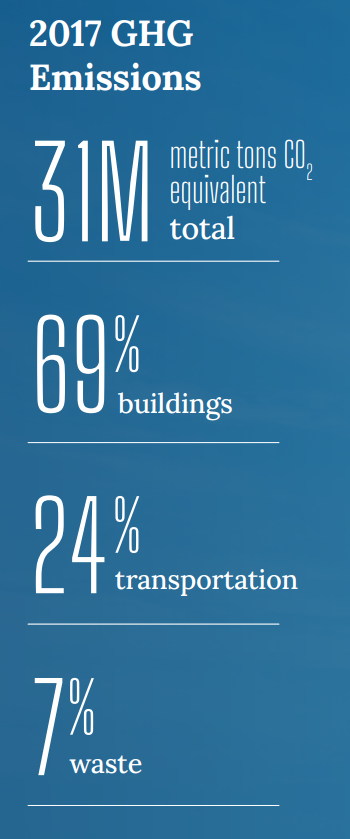Electrify Chicago
An independent tool for viewing City of Chicago building data
According to the
2022 Chicago Climate Action Plan,
69% of Chicago's emissions come from buildings, making
building emissions our biggest challenge and our biggest opportunity as a city
to tackle climate change. At Electrify Chicago, we showcase building performance using
publicly available data supplemented by community-submitted photographs and building
owners.
Start by looking at Chicago's buildings with the highest greenhouse gas intensity i.e. emissions per square foot. Large, efficient, buildings can perform much better than very inefficient small buildings on this metric.
New Article
📰 $30 Million In Missed Fines
The City Of Chicago failed to collect $30 million in potential fines from the building benchmarking ordinance, reducing transparency and accountability.
Legislative update! 🎉
As of late January 2024, legislation is being introduced to require new use more efficient forms of water and space heating, via the Clean And Affordable Buildings Ordinance (CABO), which will reduce the number of highly polluting and inefficient buildings that end up on this site.
If you're in Chicago,
write to your alderman to support the CABO!
Chicago Buildings by Greenhouse Gas Intensity
Note: Data includes large Chicago buildings with data from 2022, unless explicitly stated otherwise.
Note: This data only includes buildings whose emissions are reported
under the
Chicago Energy Benchmarking Ordinance. According to the City “As of 2016,
this list includes all commercial, institutional, and residential buildings larger than
50,000 square feet.” This dataset is also then filtered to only buildings with
reported emissions > 1,000 metric tons CO2 equivalent.
The latest year of data is from 2022, but we update the site regularly when new data is available, and some buildings may have failed to report that year, and only have older data available.
| Property Name / address | Primary Property Type |
Greenhouse Gas Intensity (kg CO2 eq./sqft) |
Total Greenhouse Emissions (metric tons CO2 eq.) |
|---|---|---|---|
|
1624 W DIVISION ST
🕰️
1624 W DIVISION ST
| Multifamily Housing | 9.4 kg/sqft | 587 tons |
|
4180 N MARINE DR
4180 N MARINE DR
| Multifamily Housing | 9.4 kg/sqft
Highest 16%
| 1,032 tons
Highest 44%
|
|
400 W Superior St
(Chicago)
400 W Superior St
| Office | 9.4 kg/sqft
Highest 16%
| 1,224 tons
Highest 38%
|
|
200 W GRAND AVE
200 W GRAND AVE
| Multifamily Housing | 9.4 kg/sqft
Highest 16%
| 1,379 tons
Highest 34%
|
|
1440 N Dayton Street
1440 N Dayton Street
| Office | 9.3 kg/sqft
Highest 17%
| 611 tons
Lowest 34%
|
|
Kedzie Plaza
🕰️
4756-4770 South Kedzie Avenue
| Strip Mall | 9.3 kg/sqft | 479 tons |
|
4540 W Belmont Ave
4540 W Belmont Ave
| K-12 School | 9.3 kg/sqft
Highest 17%
| 537 tons
Lowest 29%
|
|
Edelstone Center
6030 S Ellis Ave
| Office | 9.3 kg/sqft
Highest 17%
| 556 tons
Lowest 31%
|
|
Ellington Elementary -CPS
🕰️
(CPS)
243 N Parkside Ave
| K-12 School | 9.3 kg/sqft | 1,044 tons |
|
Randolph Elementary -CPS
🕰️
(CPS)
7316 S Hoyne Ave
| K-12 School | 9.3 kg/sqft | 731 tons |
|
Rowe-CPS
🕰️
(CPS)
1424 N Cleaver St
| K-12 School | 9.3 kg/sqft | 595 tons |
|
101 Grand
101 W Grand Ave
| Office | 9.3 kg/sqft
Highest 17%
| 579 tons
Lowest 32%
|
|
Altgeld Gardens
🚩
(CHA)
925 E 130th St
| Multifamily Housing | 9.3 kg/sqft
Highest 17%
| 11,051 tons
Highest 2%
|
|
Brennemann Elementary, Joseph -CPS
(CPS)
4251 N Clarendon Ave
| K-12 School | 9.3 kg/sqft
Highest 17%
| 498 tons
Lowest 26%
|
|
30 E Elm Condo Association
30 E ELM ST
| Multifamily Housing | 9.3 kg/sqft
Highest 17%
| 832 tons
Lowest 48%
|
Data Source:
Chicago Energy Benchmarking Data
